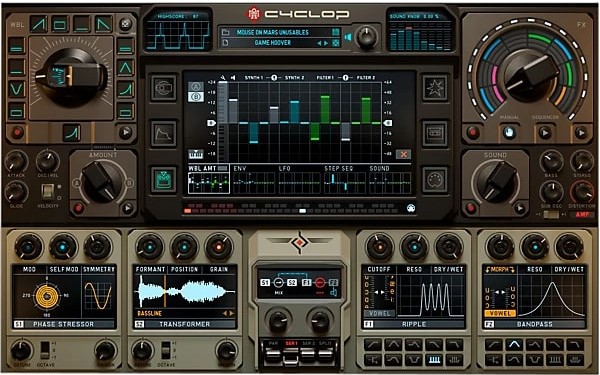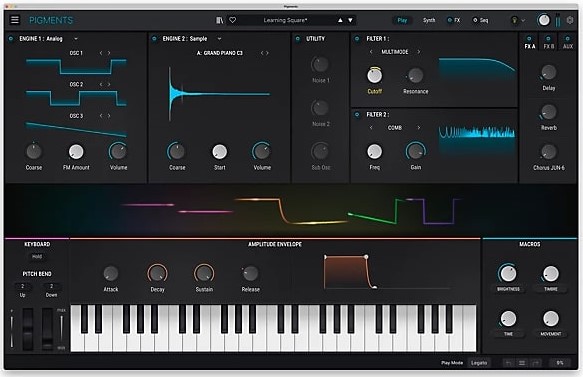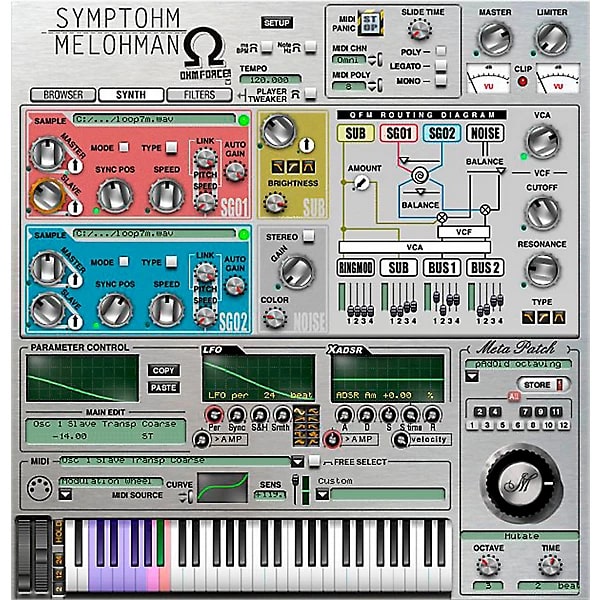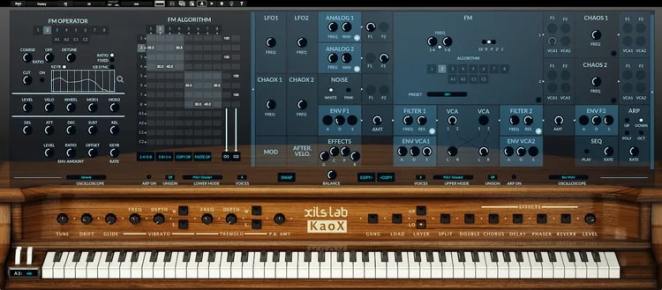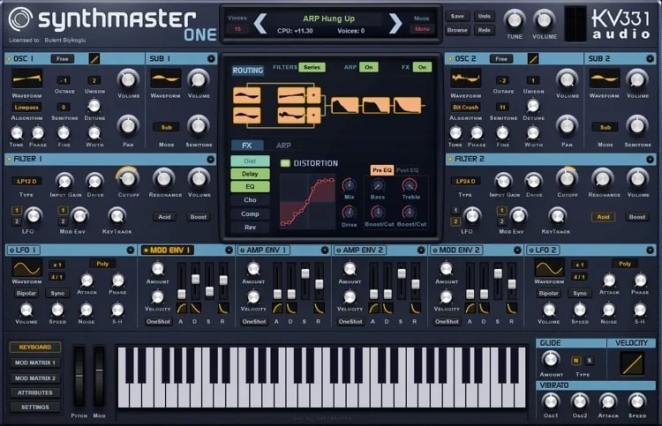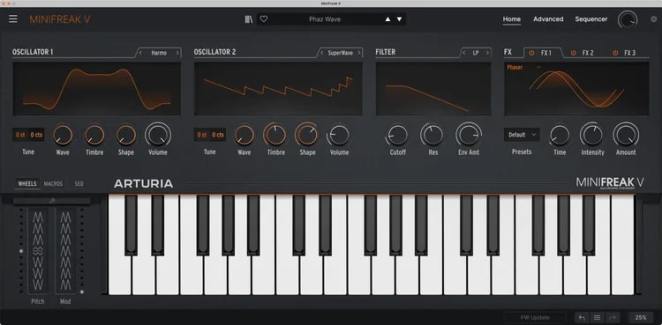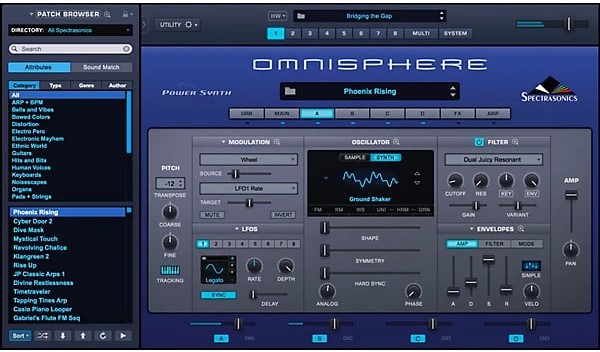When you buy through our links, we may earn an affiliate commission.
Want to create punchy leads, dirty basses, and lush textures but don't know where to start navigating the market of software synthesizers?
Digital synths may seem daunting to beginner music producers — but once you get the hang of it, they'll allow you to dial in pretty much any sound you're after.
In this article, we have picked the best synth VST for everyone: whether you're a newcomer or a veteran sound designer, we have the perfect plugin synth for you. We also threw in a buyer's guide highlighting some basic points you should know when shopping for your new favorite synth.
At the top of our list, you'll find Kilohearts' Phase Plant — a modular synth that offers endless sound design possibilities through several synthesis methods, filters, effects, and modulation links.
The perfect synth VST will let you sculpt sounds in ways you've never imagined while also providing you with hundreds of ready-to-go presets to fully reap those inspiration flashes. Keep reading to find the right one for you!
Quick Summary of the Best Synth VST
- Kilohearts Phase Plant (Best Overall)
- FabFilter Twin 3 (Best for Beginners)
- Cherry Audio Mercury-4 (Best for Classic Sounds)
- Sugar Bytes Cyclop (Best for Unique Sounds)
- Arturia Pigments (Best for Sound Design)
- Ohm Force Symptohm (Best for Granular Synthesis)
- Xils KaoX (Best for FM Synthesis)
- KV331 SynthMaster One (Best for Wavetable Synthesis)
- Arturia MiniFreak V (Best for Quick Workflow)
- Spectrasonics Omnisphere (Best for Using Presets)
Best Synth VST
Best Overall
SPECS
- Type of synthesis: Analog, granular, wavetable, sampler, and FM
- Modulation grid: Limitless
- Polyphony: Up to 64 voices
Whether you're looking to use ready-to-go presets or to design a unique sound from scratch, Phase Plant has got you covered. Don't let its rather straightforward interface deceive you — this modular synth is an absolute colossus of sound design.
Its simple drag-and-drop style allows you to move components around freely, providing a deeply customizable experience. The modulation matrix is pretty much endless, and its powerful sound engine allows everything from sampled instruments to FM synthesis. Phase Plant is, all in all, the best and most versatile synth VST out there.
Best for Beginners
SPECS
- Type of synthesis: Mostly subtractive
- Modulation grid: 100 slots
- Polyphony: Up to 64 voices
FabFilter Twin 3 manages to target something even the best synth plugins fail at — a visually informative yet beautiful interface. Everything you need to know about your audio signal is right there before your eyes, constantly reacting to your decisions and choices.
Complete with four oscillators and a drag-and-drop modulation routing; the Twin 3 will help you get a deep understanding of how you can get to that sound. And, of course, the neon spectrograms and oscilloscopes give it that extra FabFilter touch.
Best for Classic Sounds
SPECS
- Type of synthesis: FM and subtractive
- Modulation grid: One LFO only
- Polyphony: Up to 16 voices
The Cherry Audio Mercury-4 is an almost perfect imitation of the classic 1980s Roland Jupiter-4. You've probably heard this one on bands such as Duran Duran and The Human League, so rest assured that you can't get more classic than this.
Each oscillator comes equipped with an aggressive tone and a dirty sub that's ideal for raw basses, wide pads, and memorable leads. Moreover, the Mercury-4's perfect emulation of the original stereo chorus gives it that extra 80s detail.
Best for Unique Sounds
SPECS
- Type of synthesis: Saw regiment, analog sync, FM, transformer, spectromat, and phase stressor
- Modulation grid: Two LFOs, envelope, and step sequencer
- Polyphony: Monophonic
Although it markets itself as a bass synth, Sugar Bytes Cyclop is a Swiss Army knife for weird sounds — no matter the octave. Equipped with six unique synthesis modes and strange modulators, this one just doesn't follow the rules.
The looks alone should be enough to scare away any traditional sound designers. But if the conventional synth workflow just isn't cutting it for you, the Sugar Byte Cyclop will be right up your alley. Just pick a preset and move a few random knobs around — chaos will ensue.
Best for Sound Design
SPECS
- Type of synthesis: Wavetable, harmonic, granular, and FM
- Modulation grid: Limitless
- Polyphony: Up to 32 voices
A classic among soft synths, Arturia Pigments, provides an experience like no other. Combining both an intuitive interface and a precise sound-sculpting workflow, this synth plugin will give you the pilot's seat and full controls.
There's nothing missing in Arturia Pigments — deep modulation, great-sounding signal generators, filters, and versatile FXs will be your bread and butter. Pair that with a sleek interface, and this might just be the perfect synth for you if you're an advanced sound designer.
Best for Granular Synthesi
SPECS
- Type of synthesis: Granular and wavetable with ring modulation capabilities
- Modulation grid: One LFO, envelope, and MIDI
- Polyphony: up to 8 voices
Ohm Force Symptohm wants to offer a new approach to synthesis — and boy does it deliver. Focused on granular synthesis, this sonic goldmine is able to provide anything from weird sci-fi sound effects to realistic instrument emulations.
Of course, this granular approach is a bit different than what most people are used to, so it may take some time to get your desired sounds at first. But don't fret about it: the 1000+ presets included in the Symptohm will get you pretty close.
SPECS
- Type of synthesis: FM
- Modulation grid: One LFO and one envelope
- Signal generator: Up to 16 voices
Xils KaoX is great for getting back to basics: FM (frequency modulation) synthesis, eight operators, and two outputs. What else could sound designers ask for? Oh, yes: a sleek, user-friendly GUI that imitates that of analog synths.
Complete with a chaotic option for when you're running out of inspiration, Kils KaoX is the perfect tool for creating lush and living sounds. And to top it all off, the two analog-like filters allow you to carve every patch to taste.
Best for Wavetable Synthes
SPECS
- Type of synthesis: Mostly wavetable
- Modulation grid: Two LFOs and four envelopes
- Polyphony: Up to 32 voices
Most synth plugins nowadays take wavetables for granted, and KV331 SynthMaster One is here to change that. Forget about using wavetables just as a way to get a starting sound — this one wants you to use them as a fully fleshed-out synthesis method.
Whether you're looking to create breathing sounds that morph over time or realistic, punchy instrument stabs, KV331 SynthMaster One is the right tool. Also, its single-layer, single-screen design makes it a fantastic wavetable synthesizer for beginner music producers.
Best for Quick Workflow
SPECS
- Type of synthesis: 22 synthesis modes
- Modulation grid: 7 x 13 matrix
- Polyphony: Up to 6 voices
The MicroFreak has become one of the biggest chart-breakers in the hardware synthesizers world — and its soft synth brother doesn't fall behind. The Arturia MiniFreak V has everything you need to create amazing sounds in a matter of minutes.
Its double engine provides an outstanding 22 oscillator modes to tailor the needs of every sound design enthusiast. The Arturia MiniFreak V also provides analog filter emulations, 10 FXs, and an easy-to-understand modulation matrix. What more could one ask for?
Best for Using Presets
SPECS
- Type of synthesis: Mostly wavetable
- Modulation grid: Two LFOs and four envelopes
- Polyphony: Up to 64 voices
And, of course, the one and only couldn't be missing from this list. Spectrasonics Omnisphere is the essential pick for those who just want to make music without worrying about synthesis or sound sculpting.
With over 14000 presets included, Spectrasonics Omnisphere is a true beast among soft synths. Each patch has four layers that are fully customizable thanks to the vast synthesis engine behind the curtain. The only downside? You may lose dozens of hours just listening to the amazing patches included.
Best Synth VST Buyer's Guide
Our synth plugins buyer's guide covers the whole range of software synthesizers on the market. While veteran sound designers will already know most of this info, newcomers to the synthesis world may not know where to start when shopping for synth VSTs.
From emulations of classic analog synths to ground-breaking new releases, keeping these tips in mind will help you find the right tool for the job.
Type of Synthesis
Determining which synthesis method is right for achieving a certain sound is no easy task. You could spend years studying just one of these, and you probably won't get to the bottom of it. But, to make things easier for you, we've compiled the five most common types of synthesis:
- Additive synthesis: maybe the most simple type of synthesis, additive synths stack simple waveforms together to create more complex sounds. Useful for crafting very specific sounds, but may take a long time to get there.
- Subtractive synthesis: the opposite of additive synthesis — you start with very complex signals (such as noise), and shape sounds through filters and modulation. Useful for quickly getting sounds with rich timbres but not as good for precise sound design.
- FM synthesis: the dominating sound of the 80s, FM synth plugins achieve unique sounds by modulating the frequency of a given signal at high speeds. Useful for creating almost any type of sound, but it can be somewhat hard to get a grasp of.
- Wavetable synthesis: instead of generating sound from zero, wavetable synths read an already-defined waveform and use it as the building block. Useful for getting good sounds right out of the gate, but the size of the wavetable can sometimes limit your inspiration.
- Granular synthesis: a more modern type of synthesis, granular achieves deep and lush timbres by repeating extremely short samples (called grains) at high speeds. Useful for creating breath-taking soundscapes but not as good for crafting leads and low-frequency sounds.
There isn't a type of synthesis that's universally the best — each one of these tailors different needs and workflows. Our best advice is to get a soft synth that's capable of multiple types of synthesis and just try them out! Some are more intuitive than others, and you'll quickly find what's best for you.
Polyphonic Capabilities
Polyphony refers to one simple concept: how many notes (voices) a synth can play simultaneously. Back when the first hardware synthesizers were released, the technology only allowed for one note at a time (monophony), which limited musicians and sound designers alike.
However, over the years, synths were able to provide two-voice polyphony (duophony). You'll find that most synth plugins are capable of at least four-voice polyphony, with some going up to 64-note or even 128-note.
Although polyphony is king today, some bass synth plugins still go for the monophonic or duophonic approach. This allows for more precise control over the sound and a more analog-like experience.
It's also worth mentioning paraphony, which is a specific type of polyphony. Unlike true polyphony, which allows each note to have its own filters and articulations, paraphonic synths make the notes share at least one of these elements. This is the case with, for example, the Arturia MicroFreak V. While paraphony is not necessarily a limitation, it may require some changes in how you play specific sounds.
Modulation Capabilities
Although it may seem simple at first, modulation is what gives synth plugins that ever-changing sound. In fact, you may notice that pretty much any advanced synth patch or preset uses modulation — and for a good reason.
Modulation is, in short, the capability of affecting a specific parameter based on another element of the synth. For example, you could link the pitch of an oscillator to an envelope that changes depending on how hard you hit a note. This would, in turn, change the overall tuning of the sound depending on the force you apply to your keyboard.
The depth of the modulation matrix of a synth is what determines, in part, how complex it can get. Almost all synth VSTs offer at least an LFO and an envelope dedicated to modulation. But the best plugins, like Phase Plant, offer pretty much limitless modulation capabilities, allowing you to link any parameter to any knob.
Filters and Effects
A common mistake beginners often make when shopping for synth VST plugins is glossing over the extra tools needed to sculpt sounds. Filters and effects are just as essential as the number of operators or the types of synthesis offered by the plugin.
Filters, on one hand, allow you to carve or emphasize specific frequency areas in the sound. You'll find that the best synth plugins have at least two filters, sometimes allowing you to add as many as you need. If you're a beginner, we recommend you look for software synths that emulate analog filters with a graphical interface.
Effects, on the other hand, give your sound that extra final touch. Any decent VST synth will come with a reverb and a delay — but the best VST synthesizers will also provide distortion, compressor, and modulation effects, among others.
Frequently Asked Questions (FAQs)
Do hardware synths sound better than software?
Not necessarily. While the question of analog vs digital is as old as computers themselves, there isn't a true answer.
Some people argue that hardware synthesizers have a warmer, more real tone, while others say that digital synth plugins sound exactly the same. Theoretically, there shouldn't be any differences when it comes to sound generation and quality. The only actual difference is filters — which are slightly better in analog units.
How hard is it to learn sound synthesis?
Synthesizers are just like any other instrument. Handling advanced synths often requires at least some knowledge of synthesis theory, as well as a good amount of experience with effects, filters, and modulation.
But don't worry! There are thousands of tutorials online that can help you understand the basics of sound design. From there, it's all about trial and error — we recommend you stick to one plugin and just explore trying to imitate those classic synth sounds.
Do you need to learn piano before synthesizer?
Learning piano before diving into VST synths is not necessary, but it definitely helps. Of course, you don't need to be able to play all of Chopin's nocturnes — but knowing the note names, basic scales, and a few chords will get you a long way.
You'll find that most hardware synthesizers aren't equipped with a traditional keybed. Instead, they often opt for smaller and lighter keys that are preferable for simple playing. The same concept applies to VSTs and MIDI keyboards.
What is the difference between a VST and a plugin?
You can think of plugins as "programs within programs." You'll find that your preferred digital audio workstation will usually come with a few stock synth plugins, which open up a new window that runs inside the DAW and affects a specific track.
A VST is the most common format for plugins. Other formats include AAX, AU, and RTAS. You'll also encounter both VST2 and VST3 extensions in nearly all modern synth plugins — we recommend you install both and only use VST2 if VST3 doesn't work.
Does every VST work with every DAW?
Theoretically, yes. Nearly every DAW on the market today accepts VST plugins, and there isn't a reason why a specific plugin shouldn't be compatible with your DAW.
But, as with all things digital, your mileage may vary. VSTs may not work properly for a lot of reasons, such as CPU architecture, incompatible OS, faulty drivers, and any other cause you can imagine. If you're having problems with a specific synth plugin, reach out to both the manufacturer's and your DAW's support team!
Verdict
A lot of factors will cross your mind while shopping for the best synth plugins. But by far, the most important thing to consider is the method of synthesis you prefer. From additive to granular, modern synths are capable of anything you can imagine — and much more.
Modulation capabilities are also an important thing to keep in mind. Although most hardware synths provide a somewhat limited matrix, a software synth will let your imagination run wild. You should also consider extra sculpting tools (such as filters and effects) and a visually appealing interface while shopping.
If you just want to get straight to the point and buy the best synth VST on the market, take a look at Kilohearts Phase Plant. Or, if you're a newcomer and don't know where to start, we recommend FabFilter's Twin 3 instead.



